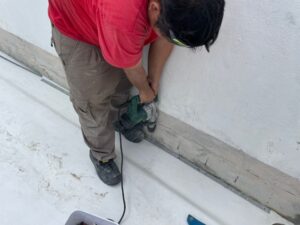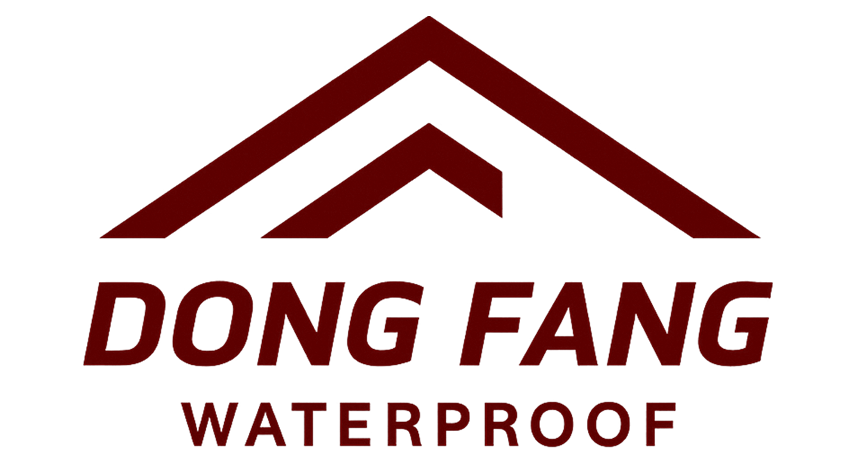Thermoplastic Polyolefin Membrane (TPO)
Thermoplastic Polyolefin (TPO) waterproofing solution is a highly effective material used in construction to provide protection against water infiltration. It’s a synthetic membrane composed of a blend of rubber and plastic, typically ethylene-propylene rubber and polypropylene. TPO membranes are known for their durability, flexibility, and resistance to UV radiation and chemicals.
These membranes are heat-weldable, making installation easier and ensuring seamless seams that prevent water penetration. TPO waterproofing solutions are commonly used in roofing systems, particularly for flat or low-slope roofs in both residential and commercial buildings. They offer excellent weather resistance and longevity, often lasting for decades with minimal maintenance.
Overall, TPO waterproofing provides a reliable and cost-effective solution for protecting structures from water damage, while also offering energy-saving benefits due to its reflective surface.
Advantages
- Durability: TPO membranes resist tears and punctures, ensuring long-term building protection.
- Flexibility: They adapt to building movements without cracking, especially in variable temperatures.
- UV Resistance: Inherently UV resistant, maintaining integrity under sunlight exposure.
- Chemical Resistance: Resists degradation from environmental chemicals, ensuring stability.
- Heat-Weldable Seams: Heat-welded for strong, seamless seams preventing water infiltration.
- Reflectivity: Reflects sunlight, reducing heat absorption and cooling costs.
- Ease of Installation: Lightweight and easy to handle, facilitating quick installation.
- Low Maintenance: Requires minimal upkeep post-installation, reducing long-term costs.
- Environmentally Friendly: Often recyclable, contributing to sustainability efforts.
- Cost-Effectiveness: With durability and easy installation, it’s a cost-effective solution for long-term waterproofing.




Insulative Thermoplastic Polyolefin System (TPO)
TPO Waterproofing with XPS Insulation Board combines the benefits of TPO membranes for waterproofing and XPS insulation boards for thermal insulation. This integrated system offers comprehensive protection against water intrusion and thermal bridging, making it ideal for a wide range of construction applications, particularly flat or low-slope roofs.
Advantages
- Waterproofing: TPO membranes offer durable, flexible, and UV-resistant protection against water infiltration.
- Thermal Insulation: XPS boards provide excellent thermal resistance, reducing energy consumption.
- Integration: TPO membranes and XPS boards seamlessly combine to create a continuous barrier against water and thermal bridging.
- Energy Efficiency: The system enhances energy efficiency, reducing heating and cooling costs.
- Durability: Both TPO membranes and XPS boards ensure long-lasting performance.
- Ease of Installation: Simplified installation saves time and labor costs.
- Versatility: Suitable for various applications, offering versatile solutions for different building requirements.



Torch-on Membrane System
The Torch-On Membrane Waterproofing System is a popular method used in construction for creating watertight barriers in various building applications, particularly flat or low-slope roofs. In this system, modified bitumen sheets are applied to the roof surface using a torch to melt the bottom layer, which adheres to the substrate, forming a seamless and durable waterproofing layer.
Advantages
- Modified Bitumen: Polymer-modified bitumen enhances flexibility, durability, and resistance to temperature changes.
- Torch Application: Installation involves heating the membrane with a torch for a strong bond.
- Seamless Construction: Melted bitumen forms seamless seams, preventing water infiltration.
- UV Protection: Some membranes have UV-resistant finishes, extending their lifespan.
- Versatility: Suitable for various surfaces like concrete, metal, and wood substrates.
- Durability: Resistant to weathering, punctures, and chemicals for long-term performance.
- Cost-Effectiveness: Offers durability and reliability at a reasonable price point.



SBS Membrane System
The SBS (Styrene-Butadiene-Styrene) membrane system is a widely used waterproofing solution in construction, especially for flat or low-slope roofs, plaza decks, and below-grade applications. This system consists of prefabricated sheets made of bitumen modified with SBS polymers, providing enhanced flexibility, durability, and resistance to temperature variations.
Advantages
- Flexibility: SBS polymers enhance flexibility, preventing cracking in extreme temperatures.
- Waterproofing: SBS membranes create a seamless barrier against water infiltration, protecting structures from moisture damage.
- Ease of Installation: Available in various configurations for easy installation, suiting different project needs.
- Durability: Bitumen-SBS combination withstands harsh conditions like UV exposure and chemicals.
- Root Penetration Resistance: Some SBS membranes resist root damage, ideal for green roofs.
- Compatibility: Versatile installation on multiple substrates, including concrete and metal.
- Cost-Effectiveness: Offers advanced performance at a competitive price, ensuring long-term value.




Water-base Coating System
The acrylic coating system on concrete, exposed with UV resistance, is a versatile and durable solution for protecting and enhancing concrete surfaces in various construction applications. This system typically involves the application of acrylic-based coatings that are specially formulated to withstand exposure to sunlight and harsh weather conditions.
Advantages
- UV Resistance: Protects concrete from sunlight damage and discoloration.
- Durability: Tough coating shields against water, chemicals, and abrasion.
- Fibermesh Reinforcement: Enhances strength and reduces cracking.
- Outlet Detailing: Ensures watertightness around drains and pipes.
- Versatility: Offers various application methods, finishes, colors, and textures.
- Low Maintenance: Easy to clean and requires minimal upkeep.
- Environmental Benefits: Low VOCs make it eco-friendly for green projects.



PU Injection
PU injection on concrete roof soffit involves injecting polyurethane foam into voids or cracks to repair and reinforce the structure. This process is commonly used to restore the integrity of concrete soffits and prevent further damage.
Advantages
- Seamless Repair: PU injection fills voids and cracks seamlessly, restoring the structural integrity of concrete soffits.
- Waterproofing: Polyurethane foam creates a waterproof barrier, preventing water infiltration and associated damages.
- Quick and Non-Disruptive: Injection process is fast, minimally invasive, and requires no excavation, reducing downtime and disruption.
- High Strength: Polyurethane foam expands and hardens, providing high-strength reinforcement to the concrete structure.
- Versatility: Suitable for various types of concrete structures and applications, including roofs, bridges, and tunnels.
- Cost-Effective: PU injection offers cost-effective repairs, avoiding the need for extensive reconstruction or replacement.
- Long-Lasting: Provides durable repairs, extending the lifespan of concrete structures and reducing maintenance needs.
- Environmentally Friendly: Polyurethane foam is non-toxic and non-hazardous, posing minimal environmental impact during and after application.
Polyurethane Coating
Polyurethane coating in a non-exposed system is a protective layer applied to surfaces to safeguard them against various environmental elements without direct exposure to external factors such as sunlight, moisture, or mechanical abrasion. Here’s a brief overview:
Polyurethane Coating: This coating is formulated with polyurethane resins, which offer exceptional durability, flexibility, and resistance to chemicals and abrasion.
Non-Exposed System: Unlike exposed systems where coatings directly face environmental elements, non-exposed systems are shielded from direct exposure, typically installed beneath other layers or within enclosed spaces.
Advantages
- Robust Protection: Shields surfaces from moisture, corrosion, and chemical damage.
- Long-Lasting Durability: Resists UV, abrasion, and harsh chemicals for extended service life.
- Seamless Application: Forms a continuous, uniform layer without weak points.
- Flexible Performance: Accommodates substrate movements without cracking or delamination.
- Versatile Application: Suitable for various substrates like concrete, metal, wood, and plastic.
- Low Maintenance: Requires minimal upkeep, reducing long-term costs.
- Environmentally Friendly: Many formulations are low in VOCs, minimizing environmental impact



